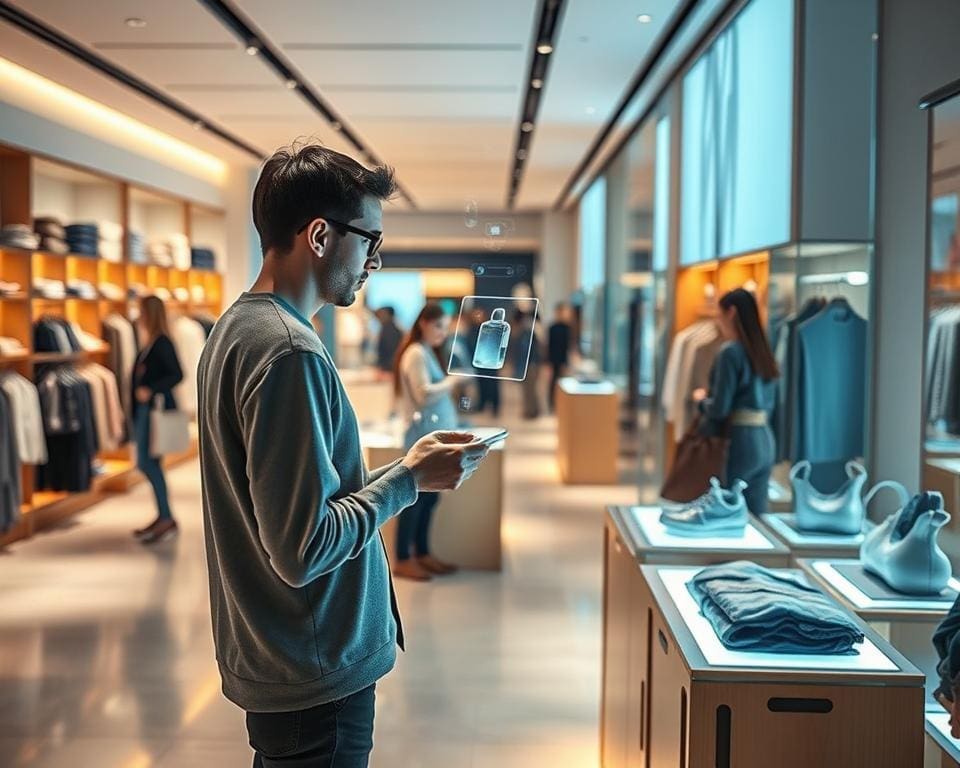In an era defined by rapid technological advances, the question arises: how will augmented reality change retail shopping? Augmented reality in retail is not merely a novelty; it is a transformative force reshaping the landscape of consumer experiences. Retailers are increasingly integrating AR technology to craft immersive visuals and interactive elements that not only captivate shoppers but also enhance customer engagement significantly. With AR, the shopping experience is evolving, bridging the divide between physical and digital realms. As consumers begin to embrace these innovative approaches, they will come to expect an elevated retail environment that offers unique experiences. Ultimately, transforming retail shopping with AR stands to redefine how individuals engage with products and brands, promising an exciting future for the industry.
Understanding Augmented Reality in Retail
Augmented reality, or AR, represents an innovative bridge between the digital and physical realms, seamlessly merging virtual content with the real world. This technology can be experienced through devices such as smartphones and AR glasses. The fascinating aspect of augmented reality in retail lies in its ability to enrich customer interactions through immersive experiences that traditionally lacked a digital component.
As retailers strive to enhance their offerings, AR technology in the retail sector has emerged as a pivotal solution. Applications like virtual try-ons allow customers to visualise how products will look before making a purchase. Similarly, interactive displays transform traditional shopping into an engaging adventure, where customers can explore options at the touch of a button. This shift towards enhancing retail with augmented reality indicates a promising evolution in consumer engagement.

Diving deeper into the AR technology in the retail sector, features such as 3D modelling, gesture recognition, and GPS-based location services stand out. Notable companies like IKEA and Sephora are at the forefront, skilfully employing AR solutions to elevate customer experiences. Statistics reveal impressive improvements in customer retention rates and satisfaction, establishing the necessity of integrating technology into the shopping experience to meet modern consumer expectations.
The Impact of AR on Shopping Experience
The integration of augmented reality (AR) into the retail landscape has revolutionised the shopping experience. Retailers are discovering the profound impact of AR on shopping experience, engaging customers in ways that were previously unimaginable. Interactive and immersive experiences foster a stronger connection between brands and consumers, leading to increased loyalty and satisfaction.
Enhanced Customer Engagement
With AR technology, brands can provide customers with an enhanced retail experience that goes beyond simple transactions. Retailers like IKEA have leveraged AR applications to enable customers to visualise furniture in their own homes, helping them make informed choices about their purchases. Virtual fitting rooms, utilised by companies such as ASOS, allow shoppers to try on clothes before committing to a purchase. These dynamic interactions not only enhance customer engagement but also increase the time spent engaging with brands, further solidifying their connection.
Personalised Shopping Journeys
The capability of AR to deliver personalised shopping journeys stands at the forefront of its transformative power. By analyzing consumer behaviour and preferences, retailers can utilise AR to curate tailored recommendations and promotions. This adaptability ensures that each customer enjoys a unique experience, making product offerings feel more relevant and engaging. Brands excelling in personalisation through AR stand to gain a competitive edge in today’s saturated market, enhancing customer satisfaction and driving sales.
How will augmented reality change retail shopping?
The retail landscape is experiencing a significant transformation as augmented reality becomes more prevalent. This technology not only enhances customer experiences but also shifts consumer expectations. As shoppers increasingly seek brands that offer innovative, tech-driven interactions, the transformative effects on consumer behaviour are becoming apparent. Understanding how will augmented reality change retail shopping is essential for businesses aiming to stay competitive in this evolving market.
Transformative Effects on Consumer Behaviour
Augmented reality influences how consumers think about and engage with products. Shoppers are drawn to experiences that allow them to visualise items in their own environments or try on virtual apparel before making a purchase. Data shows a growing interest in AR-enhanced shopping, with many consumers eager to utilise this technology to streamline their buying decisions. This shift pushes brands to adapt their strategies, as expectations for engaging interactions rise. Retailers that embrace AR are more likely to build lasting connections with customers, ultimately shaping the future of shopping with AR.
Integration with E-commerce Platforms
The integration with e-commerce platforms is crucial for the success of augmented reality in retail. Leading brands such as ASOS and Amazon are pioneering this movement by embedding AR features in their online shopping experiences. These tools facilitate a smooth transition between browsing and purchasing, enabling customers to interact with products in a meaningful way from the comfort of their homes. This integration not only fuels consumer interest but also enhances the likelihood of conversion, solidifying loyalty and satisfaction. As AR continues to evolve, it will redefine how consumers navigate the online marketplace.
Benefits of AR in Retail
The implementation of AR technology in retail presents significant advantages for both brands and consumers. Retailers increasingly recognise the profound impact of this emerging technology on their operational efficiency and customer satisfaction. Two key benefits include increased sales conversion rates and reduction in return rates, reshaping the shopping landscape as we know it.
Increased Sales Conversion Rates
Augmented reality offers a unique shopping experience, enabling customers to interact with products in immersive ways. Virtual try-ons and interactive displays effectively engage shoppers, increasing sales conversion rates. Data indicates that retailers utilising AR can achieve conversion rate boosts of up to 30%. Shoppers who can virtually assess the product often feel more confident in their purchasing decisions, leading to fewer abandoned carts and higher profits.
Reduction in Return Rates
High return rates have long posed challenges for retailers, especially in online channels. AR technology provides solutions by allowing consumers to visualise products and assess fit before making a commitment. Through enhanced understanding of product attributes, customers are less likely to encounter dissatisfaction post-purchase. Brands that have embraced AR report a noticeable reduction in return rates, directly correlating with improved customer satisfaction and loyalty.
AR Trends in Retail Shopping
The integration of AR in retail has led to remarkable transformations in how brands engage with their customers. Innovative use cases are paving the way for a new retail experience, allowing consumers to interact with products in ways that were previously unimaginable. Popular brands such as Nike and Gucci have utilised AR technology to create campaigns that captivate tech-savvy shoppers and build deeper connections.
Through immersive experiences, these brands highlight the potential of AR in retail, making shopping not just a transaction but a memorable journey. By leveraging augmented reality, companies can offer virtual try-ons or showcase their products in a customer’s own environment. This innovative approach not only enhances the shopping experience but also aligns with consumer preferences for interactive and engaging content.
The role of social media and influencers becomes crucial in amplifying these AR trends. Platforms like Instagram and Snapchat have emerged as leaders in providing AR filters, enabling brands to reach wider audiences. Influencers are essential in demonstrating AR experiences, effectively increasing product visibility and desirability. Customers find familiarity and trust through their favourite influencers, which encourages interaction with AR content and, ultimately, drives engagement across these platforms.
As AR continues to evolve, its impact on retail shopping remains profound. Brands that adopt these trends position themselves at the forefront of consumer engagement, showcasing innovative applications that resonate with today’s shoppers.
Future of Shopping with AR
The future of shopping with AR is poised to redefine our retail landscape dramatically. As augmented reality technology advances, we can expect a transition towards fully immersive shopping experiences that transcend traditional boundaries. Imagine navigating virtual shopping malls from the comfort of your home, engaging with products in a way that feels almost lifelike. This evolution will not only enhance customer engagement but also introduce dynamic in-store experiences, allowing consumers to interact with merchandise as if they were physically present.
Moreover, as we explore how will augmented reality change retail shopping, the integration of artificial intelligence with AR will play a pivotal role in personalising the shopping journey. By analysing consumer preferences in real-time, retailers can tailor recommendations more effectively, making every interaction meaningful and relevant. This collaborative potential between AR and AI marks a significant paradigm shift that will create opportunities for brands to strengthen their connections with customers.
Ultimately, the inevitability of this transformation challenges retailers to embrace AR as a central element of their future strategies. To meet the ever-evolving demands of consumers, businesses must be forward-thinking, adopting innovative technologies that enhance the overall shopping experience. As augmented reality continues to advance, it will undoubtedly be a catalyst for reshaping the retail environment, inviting both consumers and retailers into a world defined by efficiency, engagement, and unprecedented personalised interactions.









